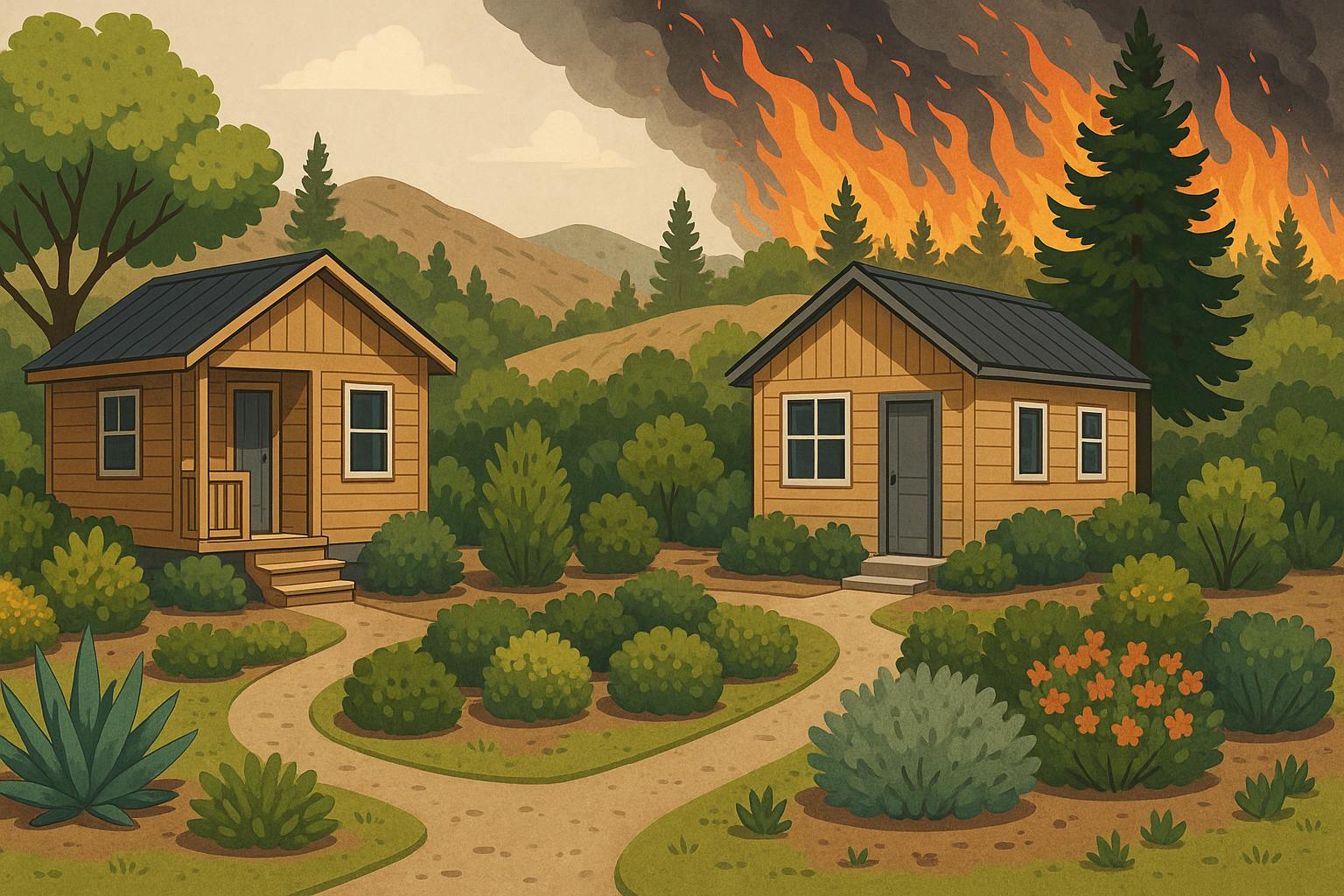
Firewise Landscaping: Wildfire Protection for Tiny Home Safety, ADU Risk Reduction, and 2025 Preparedness
Estimated reading time: 10 minutes
Key Takeaways
- Firewise landscaping minimizes wildfire damage by using fire-resistant plants, strategic spacing, and fuel reduction.
- Creating defensible spaces is essential, especially for tiny homes and ADUs with limited clearance.
- Practical steps include selecting low-flammability vegetation, implementing hardscape buffers, and regular maintenance.
- Preparedness for future wildfire risks, as projected for 2025 and beyond, requires proactive landscape planning.
Table of contents
Wildfire seasons in Canada are growing longer and more severe, and small dwellings like tiny homes and accessory dwelling units (ADUs) are especially vulnerable. Firewise landscaping—a strategic, fire-resistant yard design—offers an effective solution for wildfire protection. By prioritizing fire-resistant plants, maintaining carefully planned spacing, and creating defensible space zones, homeowners can drastically reduce the risk of fire damage.
Understanding Firewise Landscaping for Wildfire Protection
Firewise landscaping is a thoughtful approach to yard and garden design that focuses on reducing wildfire risks. It combines specific plant choices, strategic arrangement, and ongoing fuel management around structures to form a “defensible space” — making homes less likely to burn in a wildfire.
Core Principles of Firewise Landscaping
-
Plant Selection: Choose fire-resistant, low-flammability plants that keep moisture and avoid building up dead leaves or resinous material. Plants like sedum, native deciduous trees, and well-irrigated perennials are ideal.
Source: Creating a Fire-Resistant Landscape without Sacrificing Beauty
-
Spacing and Clearance: Maintain proper space between trees, shrubs, and structures to create gaps or firebreaks that disrupt fire spread. Ensuring vegetation does not touch structures or overhang roofs is key.
Sources:
FireSmart Canada Landscape Guide,
IAFC Firewise Communities Guide -
Fuel Reduction: Remove or reduce any combustible material near the home, such as dry grass, wood mulch, and dead branches. Consider replacing wood mulch with rock or gravel and keep lawns mowed and irrigated.
Sources:
Creating a Fire-Resistant Landscape without Sacrificing Beauty,
IAFC Firewise Communities Guide
By following these three principles, you create a defensible space — a safety buffer that slows fire, reduces heat, and allows firefighters easier access to your property.
Sources:
FireSmart Canada Landscape Guide,
Creating a Fire-Resistant Landscape without Sacrificing Beauty
For readers interested in related aspects of safe and efficient tiny home living, exploring guides on
Tiny Home Living: Your Complete Guide to Micro Homes, Sustainability, and Lifestyle Freedom
can provide deeper insights into optimizing compact living spaces in harmony with safety and sustainability.
Wildfire Protection Strategies for Tiny Home Safety and ADU Risk Reduction
Tiny homes and ADUs, while efficient in space, face unique risks. With limited space, combustible plants or materials can be much closer to the structure, so every metre counts.
Hardscape Buffers for Tiny Home Safety
Use non-flammable materials like gravel, concrete, or stone to create a 0–1.5 metre (0–5 foot) barrier around your dwelling. This hardscape band helps prevent flames from reaching building walls and foundations.
Compact, Low-Flammability Vegetation
Select small, hardy shrubs or perennial ground covers for immediate surroundings. Avoid tall, resinous conifers or dry ornamental grasses. Succulents, native wildflowers, and leafy perennials with high moisture content make ideal choices.
Vertical Clearance: Stopping “Ladder Fuels”
Prune low branches of nearby trees and remove any limbs that hang above roofs or eaves to prevent fires from climbing from ground-level vegetation into higher canopies.
These scaled firewise landscaping strategies not only enhance tiny home safety and ADU risk reduction but also ensure the limited space available is effectively used.
Sources:
Creating a Fire-Resistant Landscape without Sacrificing Beauty,
FireSmart Canada Landscape Guide
For more detailed insights on maximizing the functionality and safety of tiny homes and ADUs, check out
Tiny Home Design in Canada: Expert Tips for Maximizing Small Living Spaces.
Defensible Space Creation for Tiny Homes and ADUs
“Defensible space” refers to the buffer area around a building that lowers radiant heat, slows the spread of fire, and improves safety for both residents and first responders. This is especially critical for tiny homes and ADUs.
Step-by-Step Guide to Creating Defensible Space
Zone 0 (0–1.5 m / 0–5 ft): The Immediate Non-Combustible Zone
- Clear away piles of leaves, pine needles, wood mulch, and firewood from around the dwelling.
- Use non-flammable, inorganic materials such as rock, crushed stone, concrete, or pavers near the exterior walls.
- Avoid storing combustible items like patio furniture or lumber in this area.
Zone 1 (1.5–10 m / 5–30 ft): The Managed Landscaping Zone
- Plant only fire-resistant, low-flammability species such as lilac, dogwood, or leafy perennials.
- Keep grass trimmed and well-watered, and space trees and shrubs so that their crowns do not touch.
- Regularly remove dead plant matter to prevent fuel buildup.
Zone 2 (10–30 m / 30–100 ft): The Transition and Thinned Zone
- Space trees adequately and prune lower limbs (aim for pruning at 2+ m / 6+ ft).
- Thin out shrubs and clear away deadwood or debris to stop fire from bridging gaps.
Ongoing Maintenance
- Clean gutters, eaves, and areas under decks frequently to prevent debris buildup.
- Rake, prune, and irrigate during fire season.
- Monitor for new growth or material that could form additional fire pathways.
These steps form a layered defensive strategy for your tiny home or ADU.
Sources:
FireSmart Canada Landscape Guide,
Firewise Plant Materials,
Creating a Fire-Resistant Landscape without Sacrificing Beauty,
Skagit MG Firewise
For complementary advice on maintaining your ADU, consult
ADU Maintenance Checklist: Essential Seasonal Care Tips for Canadian Homeowners.
ADU Risk Reduction Through Landscaping
ADUs often sit close to main dwellings or outbuildings, which increases risks from ember intrusion and limits firefighting access. Strategic landscaping can help mitigate these risks.
Managing Combustible Storage and Structures
Keep all combustible materials like firewood, lumber, and yard tools away from the ADU. Regularly sweep under decks to remove dry debris.
Ember Intrusion Protection
Install metal mesh screens on soffits, attic vents, and crawlspace entries to prevent embers from entering and igniting interior spaces.
Fire-Resistant Fencing and Green Barriers
Instead of traditional wood fencing, use metal, treated wood, or “green fences” (irrigated hedges of broadleaf evergreens) that are strategically spaced apart from structures.
Pruning and Clearing
Regularly prune trees and clear bushes around the ADU to eliminate ladder fuels and maintain open access for emergency services.
Example: A secure FireSmart ADU property might feature a gravel band, stone pathways, low flammability ground cover like heather, and well-pruned tree branches.
Sources:
Skagit MG Firewise,
FireSmart Canada Landscape Guide,
Creating a Fire-Resistant Landscape without Sacrificing Beauty
For more creative outdoor design techniques suitable for compact Canadian gardens, see
Landscaping Ideas for ADUs: Creative and Practical Strategies to Boost Curb Appeal in Canadian Gardens.
Preparing for 2025 and Beyond: Firewise Landscaping and Wildfire Protection
With climate change increasing wildfire risks, longer and more intense fire seasons are projected for 2025 and beyond. Early and sustained preparedness is essential.
Proactive Steps for Wildfire Protection
- Re-evaluate your landscaping regularly: Inspect your property each spring and fall to update planting, spacing, and buffer zones with current firewise guidelines.
- Integrate with overall wildfire planning: Combine your landscaping efforts with fire-resistant building upgrades, a drafted evacuation plan, and community-based FireSmart initiatives.
- Act now for 2025 preparedness: Immediate proactive measures can help safeguard homes, families, and communities during critical moments.
Sources:
Creating a Fire-Resistant Landscape without Sacrificing Beauty,
FireSmart Canada Landscape Guide
For a broader perspective on future-ready tiny home design incorporating sustainability and safety, visit
Tiny Home Living: A Comprehensive Guide to Minimalist, Sustainable, and Affordable Living in 2025.
Conclusion
Firewise landscaping is a powerful tool for reducing wildfire threats. For tiny homes and ADUs, where space is limited and risks are higher, adopting these strategies is essential.
By creating defensible space, choosing fire-resistant plants, spacing vegetation properly, and maintaining your yard diligently, you enhance wildfire protection, tiny home safety, and ADU risk reduction.
Take action now to protect your property, support community resilience, and ensure peace of mind as wildfire risks continue to rise.
Sources:
Creating a Fire-Resistant Landscape without Sacrificing Beauty,
FireSmart Canada Landscape Guide
For additional guidance on meeting fire safety standards in tiny homes, check out
Tiny Home Fire Safety Canada: Comprehensive Guide to Building Codes, Compliance, and Regulations for Safe Tiny Homes.
Frequently Asked Questions
1. What is firewise landscaping?
Firewise landscaping involves designing your yard with fire-resistant plants, proper spacing, and reduced fuel loads to create a defensible space that minimizes wildfire risk.
2. How can firewise principles be adapted for tiny homes and ADUs?
Because tiny homes and ADUs have limited space, it is crucial to use compact, low-flammability plants, implement hardscape buffers, and maintain strict separation from potential fuel sources.
3. What regular maintenance is recommended for defensible spaces?
Regular tasks include clearing debris from gutters and eaves, mowing and irrigating lawns, pruning trees, and removing dry or dead vegetation to ensure the area remains fire-resistant.
4. When should I re-evaluate my firewise landscaping strategies?
It’s advisable to inspect and update your landscaping every spring and fall, or after any significant weather events, to ensure your property remains prepared against evolving wildfire risks.

Leave a Reply